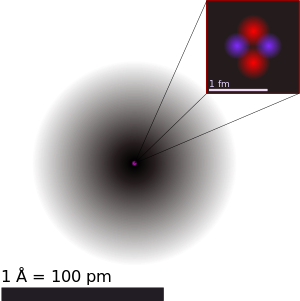Nucleus is the center of an atom. It is the most dense part of an atom. Nucleus is made of nucleus mainly consisting of neutrons and protons. Almost all of the mass of the nucleus is due to the mass of the nucleus and the electrons contribute only to a part of the atomic mass. Only the nucleus of the Hydrogen atom does not contain neutrons. Rutherford's experiment led to the discovery of nucleus.
The nucleus of an atom is highly unstable. Thus special forces are needed to hold the neutrons and protons together. These forces are very strong in nature and are called strong nuclear forces. Properties of strong nuclear forces are:
 Protons: A Proton carries a net +1 charge on it. A Proton is made up of three quarks. Two up quarks and one down quark. The 'up' quark carries a net charge of +2/3 and the bottom quark carries a charge of -1/3. Thus the charges add up to give a sum of +1 charge on the proton.
Protons: A Proton carries a net +1 charge on it. A Proton is made up of three quarks. Two up quarks and one down quark. The 'up' quark carries a net charge of +2/3 and the bottom quark carries a charge of -1/3. Thus the charges add up to give a sum of +1 charge on the proton.
Neutron: A neutron carries no charge on it. A Neutron is also made up of three quarks. One 'up' quark and two 'down' quarks. Thus the net charge is 0.
The nucleus of an atom is highly unstable. Thus special forces are needed to hold the neutrons and protons together. These forces are very strong in nature and are called strong nuclear forces. Properties of strong nuclear forces are:
- They are very strong in nature.
- They are of very short range(1-10 fm (femtometer))
- They are charge independent
- They are attractive in nature.
Composition of the Nucleus: The nucleus of an atom consists of protons and neutrons (two types of baryons) bound by the nuclear force . These baryons are further composed of subatomic fundamental particles known as quarks bound by the strong interaction. Which chemical element an atom represents is determined by the number of protons in the nucleus and its chemical properties are determined by the electrons. Each proton carries a single positive charge, and the total electrical charge of the nucleus is spread fairly uniformly throughout its body, with a fall-off at the edge.
 Protons: A Proton carries a net +1 charge on it. A Proton is made up of three quarks. Two up quarks and one down quark. The 'up' quark carries a net charge of +2/3 and the bottom quark carries a charge of -1/3. Thus the charges add up to give a sum of +1 charge on the proton.
Protons: A Proton carries a net +1 charge on it. A Proton is made up of three quarks. Two up quarks and one down quark. The 'up' quark carries a net charge of +2/3 and the bottom quark carries a charge of -1/3. Thus the charges add up to give a sum of +1 charge on the proton.









0 comments:
Post a Comment